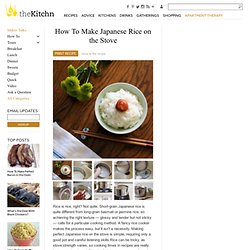

How to Cook Moist & Tender Chicken Breasts Every Time. Boneless, skinless chicken breasts (aka BSCBs) — is there anything more boring?

They are all too often overcooked until dry and chewy, and I generally prefer more succulent boneless, skinless thighs. But for lunch and dinner favorites like chicken Caesar salad and chicken pasta, sliced juicy chicken breasts can't be beat. They're a great staple for quick lunches, too. Fortunately I have one method that makes unfailingly juicy and tender boneless, skinless chicken breasts. Need some chicken for a salad, or to top some pasta? A Method That Requires Trust! This method takes trust; you can't check the chicken breasts or watch them cooking. So you can't peek, and you have to trust us. Watch the Video Error loading player: No playable sources found Simple chicken, for salads and rice bowls. Seasoning the Chicken This method alone makes plain, simple chicken breasts — a blank slate to be used on top of salads, rice dishes, and tacos.
Tester's Notes Previous image Next image What You Need Ingredients. Science of Cooking. Geschenke aus der Küche: Lecker schenken! 10 Cosmetic Uses for Everyday Foods - The Ten. The folds in a chef’s hat are supposed to symbolize the number of ways that chef knows how to prepare an egg, but we’re sure there’s at least one missing: as a facial mask. Many common foods can be used as cosmetics with surprisingly good results. So no matter your motivation (you want to save a few dollars, up your green quotient, or just find a novel way to pass the time), here are 10 cosmetic uses for food that are just as good, if not better, than their store-bought counterparts. (A word to the wise: If you have sensitive skin or processed hair, try these remedies on a small patch of skin or hair first.) 1.
Egg White Mask. 2. 10 techniques every cook should know. Breading This easy, three-step technique ensures an even crumb coating.

It's commonly used on thin cuts of chicken, pork or veal that will be fried or baked. To begin, set up your breading station. Fill the first of three shallow dishes with flour. In the second dish, make an egg wash by whisking eggs with a little bit of water, milk or other liquid or seasoning. Start by dredging a piece of meat in the flour. The second step is to dip the meat into the egg wash, again letting the extra drip off. Try to work with one hand as you complete the process, so as not to bread your fingers on both hands - that can lead to a sticky mess. Proceed with the recipe as directed.
Browning/Searing Myths abound about the benefits of searing, most notably that it seals in the juices. The most important factor in this technique is to start with a very hot pan. Place your ingredient directly into the pan. Dicing an onion. Better Egg Salad: Add an Avocado, Use Less Mayonnaise. How To Make Japanese Rice on the Stove. Rice is rice, right?

Not quite. Short-grain Japanese rice is quite different from long-grain basmati or jasmine rice, so achieving the right texture — glossy and tender but not sticky — calls for a particular cooking method. A fancy rice cooker makes the process easy, but it isn't a necessity. Making perfect Japanese rice on the stove is simple, requiring only a good pot and careful listening skills.Rice can be tricky, as stove strength varies, so cooking times in recipes are really just approximations. Lifting the lid lets steam escape from the pot, a rice cooking no-no, so the best way to check on the progress of your rice is actually to lean in close and listen. Stovetop Japanese Rice What You Need Ingredients Japanese short-grain riceWater Equipment Heavy pot with a tight-fitting lidStrainerDry measuring cupLiquid measuring cup Instructions.
50 Amazingly Helpful Time-Tested Tips for the Kitchen. You know all of those helpful kitchen-related suggestions that old-timers are so willing to share with the younger generations?

These little tips and tricks might be called “kitchen hacks” these days, but they’re still the same good old nuggets of wisdom that they always were. As with any old wives’ tale, hack, or tip, your mileage may vary. Some of these gems have been around for several lifetimes - and according to most grandmas, they really work. 1. For cleaning smelly hands after chopping onions or garlic, just rub them on a stainless steel spoon. 2.